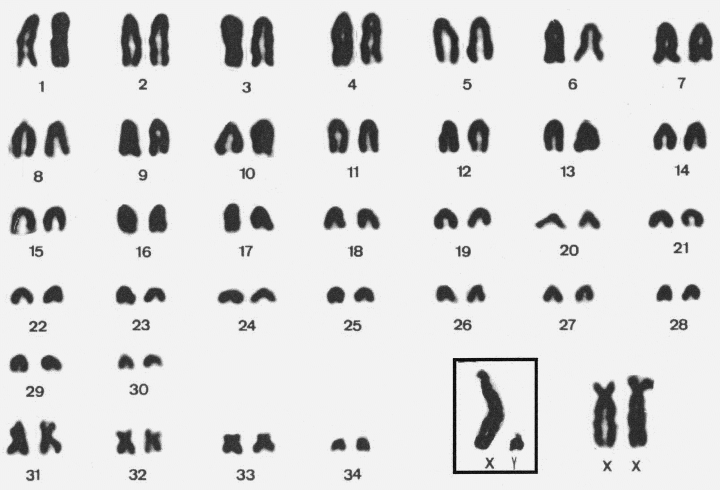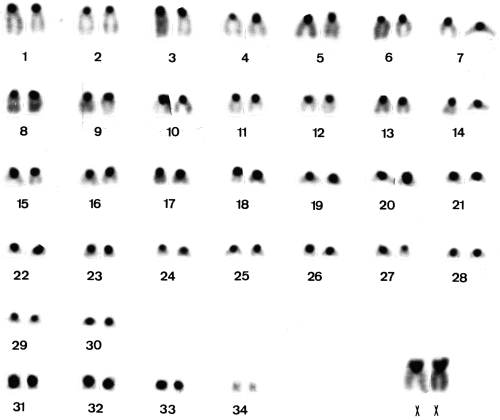A new karyotype of Oligoryzomys (Sigmodontinae, Rodentia) from central Brazil
Abstract
A new karyotype of the genus Oligoryzomys was described for specimens collected in Brazilian Cerrado in Tocantins and Goiás States. Conventional staining, G-, C-banding, and Ag-NOR staining techniques were used for describe this karyotype with 2n=70, AN=74 or 76. The chromosome complement, with the highest diploid number known among Oligoryzomys species, differs from all others previously reported. This small sized Oligoryzomys species can be differentiated from other Brazilian Oligoryzomys not only by chromosomal complement, but also in some morphological attributes. The new species is apparently restricted in distribution and endemic of Brazilian Cerrado, occurring only in Rio Tocantins basin.
The genus Oligoryzomys Bangs, 1900 has a widespread distribution, from northern Central America to the southern part of South America. Fifteen species were recognized in the latest checklist of the genus, seven of which occurring in Brazil: O. chacoensis, O. delticola, O. eliurus, O. flavescens, O. fulvescens, O. microtis, and O. nigripes (Musser and Carleton 1993). These Oligoryzomys species occur in four Brazilian biomes: Cerrado, Caatinga, Atlantic Forest and Amazon. Recently, O. stramineus, an endemic species of the Brazilian Cerrado and Caatinga was described (Bonvicino and Weksler 1998) while O. fornesi Massoia, 1973 was recognized as a valid species (Myers et al. 1995; Bonvicino and Weksler 1998). These findings extended the number of Brazilian Oligoryzomys species to nine. However, previous studies based on morphologic similarities and G-band pattern suggested that O. nigripes was as senior synonymous of O. delticola and O. eliurus (Bonvicino and Weksler 1998).
Oligoryzomys karyology, morphology, and geographic distribution have been reported in the last 25 years by many authors (Gardner and Patton 1976; Almeida and Yonenaga-Yassuda 1991; Espinosa and Reig 1991; Sbalqueiro et al. 1991; Bonvicino et al. 2001). Other inventories allow the identification of new species and karyotypes of Oligoryzomys in Brazil (Silva and Yonenaga-Yassuda 1997; Bonvicino and Weksler 1998). Due to the extreme similarity in morphological attributes among Oligoryzomys species, karyologic studies have been used to clarify the taxonomy of some species and understanding the diversification of the genus. The highest diploid number in the genus 2n=68, AN=74 or 76 was found in Peru (Gardner and Patton 1976) and the lowest diploid numbers, 2n=44, 44/45, AN=52, 52/53 in Brazil (Silva and Yonenaga-Yassuda 1997).
In this paper, we describe a new Oligoryzomys karyotype, with the highest diploid number in the genus, comment on the geographic distribution and morphological characteristics of this karyomorph, herein referred to as Oligoryzomys sp., and compare our findings with karyologic data on related species.
MATERIAL AND METHODS
We karyotyped 6 specimens of Oligoryzomys collected in the following Brazilian localities (Fig. 1: 1, Fazenda Elizeu (9°55′S, 48°17′W), Lajeado, Tocantins State: female MN LJ35; 2, Chácara União (around 10°44′S, 48°23′W), Porto Nacional, Tocantins State: female ZUT 30; 3, Fazenda Fiandeiras, Cavalcante (13°47′51′′S, 47°27′30′′W), Chapada dos Veadeiros National Park, Goiás State: females MN 50320, 50321, male MN 50318; 4, Fazenda Cadoz, Mimoso de Goiás (15°03′22′′S, 48°09′41′′W), Goiás State: female MN 67087.

Brazilian localities of occurrence of Oligoryzomys sp. with 2n=70. Tocantins State: (1) Lajeado and (2) Porto Nacional; Goiás State: (3) Cavalcante and (4) Mimoso de Goiás.
Chromosome preparations were obtained in the field from bone marrow cells, after in vivo colchicine treatment, or from short-term bone marrow cultures in RPMI 1640 (80 %), foetal bovine serum (20 %), colchicine (10−6 M) and ethidium bromide (5ug ml−1) for 2 hours (Bonvicino et al. 2001). G- and C- banding were obtained in specimens from localities 1 and 2 following Seabright (1971) and Sumner (1972), respectively. Ag-NOR staining was carried out following Howell and Black (1980). Skins and skull of specimens were deposited in the mammal collection of Museu Nacional (MN, UFRJ), Rio de Janeiro, Brazil, and in the mammal collection of Funda ção Universidade do Tocantins (ZUT, UNITINS), Porto Nacional, Tocantins State, Brazil.
RESULTS
Karyological analyses of the two specimens from localities 1 and 2 showed 2n=70, AN=76 (Fig. 2). The autosome complement is composed by 30 acrocentric pairs varying in size from large to small and 4 biarmed pairs varying in size from medium to small, the X chromosome is a large submetacentric, the greatest of the chromosome complement. The G banding allowed the identification of the chromosome pair (Fig. 3). Karyological analyses of four specimens from localities 3 and 4 showed 2n=70, AN=74. The autosome complement comprises 31 acrocentric pairs (one large pair and 30 pairs varying in size from medium to small) and 3 pairs of small sized biarmed chromosomes. The X chromosome is a large submetacentric, and the Y chromosome a small acrocentric.

Conventional Giemsa staining karyotype of Oligoryzomys sp., female ZUT 30 (2n=70, AN=76). Inset: the sexual pair of the male.

G- banded karyotype of Oligoryzomys sp., female MN LJ35 (2n=70, AN=76).
The C- banding showed pericentromeric heterochromatin in almost all autosome pairs, except the pair 34; the short arm of X chromosome is almost completely heterochromatic (Fig. 4). Ag-NORs were located in the telomeric region of the short arms of acrocentric chromosomes of large and medium size, and their number in each metaphase varies from 3 to 7, being 4 the modal number (Fig. 5).

C banded karyotype of Oligoryzomys sp., female ZUT 30 (2n=70, AN=76).

Ag-NOR bearing chromosomes of Oligoryzomys sp., female ZUT 30 (2n=70, AN=76).
Morphological comparisons allow the differentiation of the specimens of Oligoryzomys of the present sample in the following external characters: (1) a creamy ventral coloration and an undefined limit between dorsal and ventral colour against a whitish venter and a definite limit between dorsal and ventral coloration in adult specimens of O. nigripes and O. stramineus; (2) total absence of yellow hair at ventral region between forelimbs against presence of a yellow patch in O. nigripes and O. stramineus; (3) bicolour tail against tail with only one predominant color in O. nigripes; (4) completely creamy ventral side of limbs against dark coloration in O. fornesi and O. flavescens; (5) lighter dorsal and heterogeneous coloration (lined with dark and light hairs) against darker and homogeneous coloration in O. flavescens.
DISCUSSION
The specimens of Oligoryzomys sp. differed from all other Oligoryzomys species in the chromosome complement and morphology. As previously defined, the Brazilian Oligoryzomys species can be divided into two groups, the small body-size and the large body-size (Bonvicino and Weksler 1998). All small body-size Brazilian Oligoryzomys species have allopatric distributions whereas, among large body-size species, the distributions might be sympatric. The karyotypes of species belonging to the small body sized group (O. fornesi, O. microtis, O. flavescens, and Oligoryzomys sp.) shared some similarities. All of them have a predominance of acrocentric chromosomes and a variable number of few small biarmed elements, two pairs in O. microtis, O. favescens (with biarmed B chromosomes) and O. fornesi, and three or four pairs in Oligoryzomys sp. On the other hand, the species belonging to the large body sized group (O. nigripes, O. chacoensis and O. stramineus) shared a high fundamental number in respect to diploid number, due to more numerous biarmed chromosomes in the karyotype.
The two karyotypes here described shared the same diploid number (2n=70) but differ in fundamental number (AN=74 and 76). This difference is probably due to a pericentric inversion affecting a medium sized pair, biarmed in localities 1 and 2 acrocentric in localities 3 and 4. This chromosome rearrangement could not be confirmed because G-banding pattern was not available for specimens from localities 3 and 4. The karyotype of Oligoryzomys sp. showed the highest diploid number in the genus and differ from all other previously reported (Table 1). The 2n=70, AN=74 or 76 karyotypes of Oligoryzomys sp. are more similar to that of O. longicaudatus variant 1 with 2n=68, AN=74 or 76 (Gardner and Patton 1976) than those found in any other Oligoryzomys species. They differed only in the number of acrocentrics, which is 30 or 31 in the 2n=70 karyotypes and 28 or 29 in the 2n=68 karyotypes. The karyotype of Oligoryzomys sp. showed strongly stained pericentromeric heterochromatin in the majority of autosomes pairs, similar to the pattern found in some other congeneric species (Sbalqueiro et al. 1991; Espinosa and Reig 1991; Aniskin and Volobouev 1999). O. nigripes (Almeida and Yonenaga-Yassuda 1991) is one exception, presenting less stained small blocks of heterochromatin in the autosomes. In the karyotype here analysed, the Ag-NORs are restricted to the telomeric region of the short arms of medium and large sized acrocentric chromosomes, similar to the pattern found in other Oligoryzomys species (Furtado 1981, Svartman 1989; Sbalqueiro et al. 1991; Silva and Yonenaga-Yassuda 1997).
| Taxa | 2n | NA | Locality | Reference |
|---|---|---|---|---|
| O. andinus | 60 | 70 | Peru | 6 |
| O. chacoensis | 58 | 74 | Argentina; Paraguay | 8, 14 |
| O. delticola | 62 | 80–82 | Brazil: RS, PR; Argentina; Uruguay | 1, 2, 8 |
| O. destructor | 60 | 76 | Peru; Uruguay | 1 |
| O. flavescens | 64 | 68 | Brazil: MG, | 9 |
| O. flavescens | 66 | 70 | Argentina; Uruguay | 1 |
| O. flavescens | 64–66 | 66–68 | 1, 2, 8 | |
| O. flavescens | 66–68 | 68–70 | Argentina | 8 |
| O. fornesi | 62 | 64 | Brazil: DF, GO, PE | 3, 9, 12 |
| O. fulvescens | 54 | 68 | Costa Rica | 6 |
| O. fulvescens | 60 | 74 | Mexico | 7 |
| O. longicaudatus var.3 | 62 | 74,76 | Venezuela | 6 |
| O. longicaudatus var.1 | 68 | 74,76 | Peru | 6 |
| O. microtis | 64 | 66 | Peru | 6 |
| O. nigripes | 62 | 80–82 | Paraguay; Brazil: SP, RJ, ES, MG, SC, RS | 4, 5, 9, 10, 13 14, |
| O. nigripes | 62 | 78 | Brazil: BA | 10 |
| Oligoryzomys sp.1 | 46 | 50 | Brazil: BA | 11 |
| Oligoryzomys sp.2 | 44–45 | 52–53 | Brazil: MG | 11 |
| O. stramineus | 52 | 68–70 | Brazil: GO, PE | 3, 9 |
| Oligoryzomys sp. | 70 | 74,76 | Brazil: GO,TO | This work |
- Acronyms for Brazilian states are: RS=Rio Grande do Sul, PR=Paraná, SP=São Paulo, RJ=Rio de Janeiro, ES=Espírito Santo, MG=Minas Gerais, GO=Goiás, DF=Distrito Federal, TO=Tocantins and PE=Pernambuco.
Karyologic and morphologic data strongly suggest that the karyomorphotype here analysed is a new undescribed species, apparently endemic in Brazilian Cerrado, with a restricted distribution in the Rio Tocantins basin.
Acknowledgements
We are grateful to the owners of Chácara União (I.R. dos Santos), Fazenda Elizeu (B. Parente), Fazenda Cadoz and the staff of Parque Nacional of Chapada dos Veadeiros for support received; to Brazilian Institute of Environment and Natural Resources (IBAMA) for granting us a collecting license. We are grateful to A.F.B. Andrade, B. Lemos, B.R. Teixeira, C.E. Grelle, M. Weksler, M.A.M. Moreira, R. Santori, S. Lindbergh, A.C. de Paula and V. Penna-Firme for helping in the field work. Work supported by Coordena ção de Aperfei çoamento de Pessoal de Nível Superior (CAPES), Conselho Nacional de Desenvolvimento Científico e Tecnológico (CNPq-PRONEX), Departamento de Medicinal Tropical da Funda ção Oswaldo Cruz (IOC-FIOCRUZ) and Universidade do Tocantins (UNITINS).




